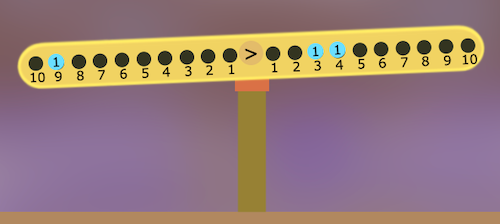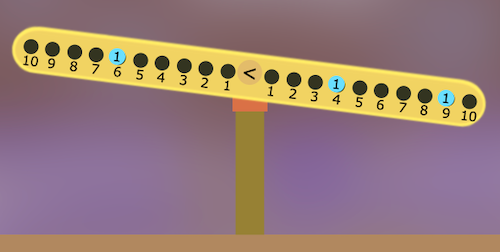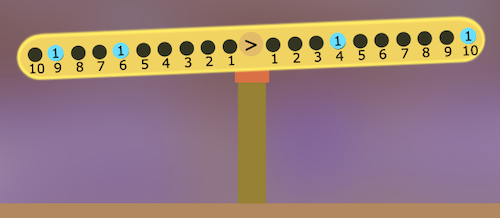Or search by topic
Number and algebra
Geometry and measure
Probability and statistics
Working mathematically
Advanced mathematics
For younger learners
Number Balance



- Problem
- Getting Started
- Student Solutions
- Teachers' Resources
Number Balance
Number Balance printable sheet
This is an interactive number balance:



Why do this problem?
This problem requires children to utilise their knowledge of number bonds in an unusual context, and offers the opportunity for them to explain and reason through their solutions.
Possible approach
This problem featured in an NRICH Primary webinar in January 2021.
Before tackling Number Balance, pupils will need practical experience of working with balances, if possible.
To introduce the problem, show the class the interactive balance on the board and, without saying anything, hang weights to make it balance (perhaps one weight on one side and two on the other to begin with). Take the weights off and put on a different combination of weights on each side to balance the equaliser. Repeat this a few times and invite learners to talk to each other in pairs about what they think is happening.
You could then try the first two examples in the problem as a whole group, asking the children to talk to each other about what they might do before sharing ideas amongst the whole group.
Ideally, for the main challenge, children would have access to the interactivity in pairs on a tablet or computer. You can also encourage them to record their ideas on paper or mini whiteboards.
After leaving time for them to work on this, bring them together and discuss their solutions. You could ask pairs to write up some solutions on individual strips of paper which can be stuck on the board. You could follow on by looking for patterns in the solutions, which may lead to the children suggesting other possibilities. Alternatively (or as well) you could focus on the number sentences that can be written from the pupils' solutions.
Key questions
Can you tell me how a balance works?
How can you tell from the pictures which side we need to add a weight to?
What is the total of the weights on this side?
What is the total of the weights on the other side?
Possible extension
You could encourage children to work systematically to find all the possible solutions to the final part of the problem. They can also create their own challenge for another pair to work on.
Possible support
Having lots of practical experience of real balances will help children access this task.
You may also like
Buzzy Bee
Buzzy Bee was building a honeycomb. She decorated the honeycomb with a pattern using numbers. Can you discover Buzzy's pattern and fill in the empty cells for her?
Fair Exchange
In your bank, you have three types of coins. The number of spots shows how much they are worth. Can you choose coins to exchange with the groups given to make the same total?
Missing Middles
Can you work out the domino pieces which would go in the middle in each case to complete the pattern of these eight sets of three dominoes?

